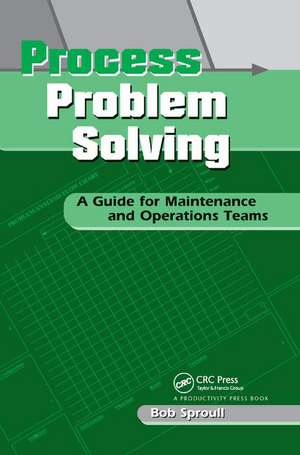Process Problem Solving: A Guide for Maintenance and Operations Teams
Autor Bob Sproullen Limba Engleză Hardback – 27 iul 2017
The central tool in Process Problem Solving is the Problem Analysis Flow (PAF) chart. Containing ten major sections, it combines many of the tools discussed at the beginning of the book. According to the author, the PAF chart is the most thorough and comprehensive problem-solving tool. It creates a systematic method for understanding and solving the root causes of problems.
To teach the necessary problem-solving skills, Sproull uses powerful learning techniques that guide the reader through the process. Each chapter begins with a section entitled "What You Should Learn in this Chapter," which specifically emphasizes the main points presented. In addition, each chapter is sprinkled with "keyword" boxes that advise the reader of important terms.
Process Problem Solving is filled with Sproull's "Problem Solving Truths." These are key ideas the author wants to highlight, so the reader retains important pieces of information. Finally, Process Problem Solving follows a "learn and do" approach. The end of each chapter asks the reader to talk about what they have learned. This interactive approach helps readers retain a
Preț: 986.91 lei
Preț vechi: 1328.85 lei
-26% Nou
Puncte Express: 1480
Preț estimativ în valută:
188.86€ • 196.06$ • 157.48£
188.86€ • 196.06$ • 157.48£
Carte tipărită la comandă
Livrare economică 24 martie-07 aprilie
Preluare comenzi: 021 569.72.76
Specificații
ISBN-13: 9781138438859
ISBN-10: 1138438855
Pagini: 192
Dimensiuni: 152 x 229 mm
Greutate: 0.45 kg
Ediția:1
Editura: Taylor & Francis
Colecția Productivity Press
Locul publicării:Oxford, United Kingdom
ISBN-10: 1138438855
Pagini: 192
Dimensiuni: 152 x 229 mm
Greutate: 0.45 kg
Ediția:1
Editura: Taylor & Francis
Colecția Productivity Press
Locul publicării:Oxford, United Kingdom
Public țintă
Professional and Professional Practice & DevelopmentCuprins
1. Understanding Problems 2. Selecting the Right Problem 3. Problem Solving Teams 4. The Why?-Why? Tools in Problem Solving 5. The Inquisition Tools 6. The Problem Analysis Flow (PAF) Chart Appendices References Index
Descriere
Standardized Work with TWI: Eliminating Human Errors in Production and Service Processes presents the Training within Industry (TWI) program and describes how it can influence and alter one‘s understanding of work standardization. Work standardization is the key to eliminating human errors from manufacturing and service processes. Work standardization is not just the creation of job instructions it is a comprehensive approach in which employees are formally trained and their skills in the area of work improvement are developed by kaizen sessions. With poor instructions, though, the effectiveness of these two key activities in the work standardization process is practically impossible to achieve.The book introduces you to 41 rules for standard work instruction (SWI) preparation. Following these rules will ensure that the instructions in your company are ideally suited to train operators and improve work. The author developed these rules based on his professional experience and practice within the TWI program in more than 120 manufacturing and service enterprises, while creating thousands of SWIs. These rules are a clear set of signposts that will help you develop a correct SWI on the first attempt without any unnecessary correction of errors. The quality of SWIs significantly affects how on-the-job training sessions are run, as well as how work analysis with respect to improvement is conducted.
